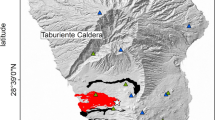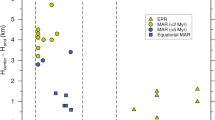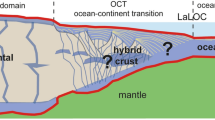Abstract
The growth of oceanic plates at mid-ocean ridges, crustal accretion, occurs by a combination of magmatic and tectonic processes. Magmatic processes along ridges spreading at fast, intermediate and slow rates, continually add volcanic material to a centrally located spreading axis. This creates a narrow band of young volcanic rocks. However, at ridges spreading at ultraslow rates, diminished volcanism allows entire blocks of mantle to spread on the sea floor by tectonic processes. Remote imaging has advanced our observational understanding of crustal accretion, but temporal constraints are required to quantitatively understand ultraslow-spreading ridge construction. Here, we use U-series eruption ages of volcanic rocks collected from the ultraslow-spreading Southwest Indian Ridge. Unexpectedly, we find young volcanic eruption ages that are broadly dispersed throughout the rift valley, indicating that crustal accretion of young volcanic rocks is not confined to a narrow central spreading axis. As areas of young volcanism are observed close to distinct fault surfaces, we propose that the widely dispersed volcanism may result from magma rising along faults. Our results indicate that axial-centric spreading models may not accurately describe crustal accretion at ultraslow-spreading ridges, prompting the re-evaluation of these models.
This is a preview of subscription content, access via your institution
Access options
Subscribe to this journal
Receive 12 print issues and online access
$259.00 per year
only $21.58 per issue
Buy this article
- Purchase on Springer Link
- Instant access to full article PDF
Prices may be subject to local taxes which are calculated during checkout



Similar content being viewed by others
References
Sinton, J. M. & Detrick, R. S. Mid-ocean ridge magma chambers. J. Geophys. Res. 97, 197–216 (1992).
Macdonald, K. C. Near-bottom magnetic anomalies, asymmetric spreading, oblique spreading, and tectonics of the Mid-Atlantic ridge near lat 37∘ N. Geol. Soc. Am. Bull. 88, 541–555 (1977).
Maclennan, J., Hulme, T. & Singh, S. Thermal models of oceanic crustal accretion: Linking geophysical, geological and petrological observations. Geochem. Geophys. Geosyst. 5, Q02F25 (2004).
Macdonald, K. C. Mid-ocean ridges: Fine scale tectonic, volcanic and hydrothermal processes within the plate boundary zone. Annu. Rev. Earth Planet. Sci. 10, 155–190 (1982).
Smith, D. K., Tivey, M. A., Schouten, H. & Cann, J. R. Locating the spreading axis along 80 km of the Mid-Atlantic ridge south of the Atlantis transform. J. Geophys. Res. 104, 7599–7612 (1999).
Solomon, S. in Drilling the Oceanic Lower Crust and Mantle: JOI/USSAC Workshop Report (ed. Dick, H. J. B.) 73–74 (Woods Hole Oceanographic Institution, 1989).
Bown, J. W. & White, R. S. Variation with spreading rate of oceanic crustal thickness and geochemistry. Earth Planet. Sci. Lett. 121, 435–439 (1994).
Jackson, H. R., Reid, I. & Falconer, R. K. H. Crustal structure near the Arctic mid-ocean ridge. J. Geophys. Res. 87, 1773–1783 (1982).
Reid, I. & Jackson, H. R. Oceanic spreading rate and crustal thickness. Mar. Geophys. Res. 5, 165–172 (1981).
Dick, H., Lin, J. & Schouten, H. An ultraslow-spreading class of ocean ridge. Nature 426, 405–412 (2003).
Sauter, D. et al. Focused magmatism versus amagmatic spreading along the ultra-slow spreading Southwest Indian Ridge: Evidence from TOBI side scan sonar imagery. Geochem. Geophys. Geosyst. 5, Q10K09 (2004).
Standish, J. J., Dick, H. J. B., Michael, P. J., Melson, W. G. & O’Hearn, T. MORB generation beneath the ultraslow spreading Southwest Indian Ridge (9∘–25∘ E): Major element chemistry and the importance of process versus source. Geochem. Geophys. Geosyst. 9, Q05004 (2008).
Michael, P. J. et al. Magmatic and amagmatic seafloor generation at the ultraslow-spreading Gakkel Ridge, Arctic Ocean. Nature 423, 956–961 (2003).
Cannat, M. et al. Modes of seafloor generation at a melt-poor ultraslow-spreading ridge. Geology 34, 605–608 (2006).
Behn, M. D., Buck, W. R. & Sacks, I. S. Topographic controls on dike injection in volcanic rift zones. Earth Planet. Sci. Lett. 246, 188–196 (2006).
Buck, W. R., Lavier, L. L. & Poliakov, A. N. B. Modes of faulting at mid-ocean ridges. Nature 434, 719–723 (2005).
Sturm, M. E., Goldstein, S. J., Klein, E. M., Karson, J. A. & Murrell, M. T. Uranium-series age constraints on lavas from the axial valley of the Mid-Atlantic Ridge, MARK area. Earth Planet. Sci. Lett. 181, 61–70 (2000).
Sims, K. W. W. et al. Aberrant youth: Chemical and isotopic constraints on the young off-axis lavas of the East Pacific Rise. Geochem. Geophys. Geosyst. 4, 8621 (2003).
Goldstein, S. J., Perfit, M. R., Batiza, R., Fornari, D. J. & Murrell, M. T. Off-axis volcanism at the East Pacific Rise detected by uranium-series dating of basalts. Nature 367, 157–159 (1994).
Patriat, P., Sloan, H. & Sauter, D. From slow to ultraslow: A previously undetected event at the Southwest Indian Ridge at ca. 24 Myr. Geology 36, 207–210 (2008).
Grindlay, N. R., Madsen, J. A., Rommevaux-Jestin, C. & Sclater, J. A different pattern of ridge segmentation and mantle Bouguer gravity anomalies along the ultra-slow spreading Southwest Indian Ridge (15∘ 30′ E–25∘ E). Earth Planet. Sci. Lett. 161, 243–253 (1998).
Sauter, D. et al. TOBI sidescan sonar imagery of the very slow-spreading Southwest Indian Ridge: Evidence for along-axis magma distribution. Earth Planet. Sci. Lett. 199, 81–95 (2002).
Mendel, V., Sauter, D., Parson, L. M. & Vanney, J. R. Segmentation and morphotectonic variations along a super slow-spreading centre: The Southwest Indian Ridge (57∘–70∘ E). Mar. Geophys. Res. 19, 503–531 (1997).
Rubin, K. H., Macdougall, J. D. & Perfit, M. R. 210Po–210Pb dating of recent volcanic eruptions on the sea floor. Nature 368, 841–844 (1994).
Rubin, K. H., van der Zander, I., Smith, M. C. & Bergmanis, E. C. Minimum speed limit for ocean ridge magmatism from 210Pb-226Ra-230Th disequilibria. Nature 437, 534–538 (2005).
Rubin, K. H. & MacDougall, J. D. Dating of neovolcanic MORB using (226Ra/230Th) disequilibrium. Earth Planet. Sci. Lett. 101, 313–321 (1990).
Zou, H., Zindler, A. & Niu, Y. Constraints on melt movement beneath the East Pacific Rise from 230Th–238U disequilibrium. Science 295, 107–110 (2002).
Goldstein, S. J., Murrell, M. T., Janecky, D. R., Delaney, J. R. & Clague, D. A. Geochronology and petrogenesis of MORB from the Juan de Fuca and Gorda ridges by 238U–230Th disequilibrium. Earth Planet. Sci. Lett. 109, 255–272 (1992).
Cooper, K. M., Goldstein, S. J., Sims, K. W. W. & Murrell, M. T. Uranium-series chronology of Gorda Ridge volcanism: New evidence from the 1996 eruption. Earth Planet. Sci. Lett. 206, 459–475 (2003).
Sims, K. et al. Aberrant youth: Chemical and isotopic constraints on the origin of off-axis lavas from the East Pacific Rise, 9∘–10∘ N. Geochem. Geophys. Geosyst. 4, 8621 (2003).
Fornari, D. J., Haymon, R. M., Perfit, M. R., Gregg, T. K. P. & Edwards, M. H. Axial summit trough of the East Pacific Rise 9∘–10∘ N: Geological characteristics and evolution of the axial zone on fast spreading mid-ocean ridges. J. Geophys. Res. 103, 9827–9855 (1998).
Sims, K. W. W. et al. Chemical and isotopic constraints on the generation and transport of magma beneath the East Pacific Rise. Geochim. Cosmochim. Acta 66, 3481–3504 (2002).
Fornari, D. et al. Submarine lava flow emplacement at the East Pacific Rise 9∘50′ N: Implications for uppermost ocean crust stratigraphy and hydrothermal fluid circulation. Geophys. Mono. Ser. 148, 187–217 (2004).
Soule, S. et al. Channelized lava flows at the East Pacific Rise crest 9∘–10∘ N: The importance of off-axis lava transport in developing the architecture of young oceanic crust. Geochem. Geophys. Geosyst. 6, Q08005 (2005).
Hooft, E., Schouten, H. & Detrick, R. Constraining crustal emplacement processes from the variation in seismic layer 2A thickness at the East Pacific Rise. Earth Planet. Sci. Lett. 142, 289–309 (1996).
Schouten, H., Tivey, M. A. & Fornari, D. J. AT7-4 Cruise Report, (2001).
Luyendyk, B. & MacDonald, K. C. Spreading center terms and concepts. Geology 4, 369–370 (1976).
Cowen, J. Volcanic eruptions at East Pacific rise near 9 50 N. Eos Trans. AGU 88, 81 (2007).
Sohn, R. A. & Sims, K. W. W. Bending as a mechanism for triggering off-axis volcanism on the East Pacific Rise. Geology 33, 93–96 (2005).
Tucholke, B. E., Behn, M. D., Buck, W. R. & Lin, J. Role of melt supply in oceanic detachment faulting and formation of megamullions. Geology 36, 455–458 (2008).
deMartin, B., Sohn, R. A., Canales, J. P. & Humphris, S. E. Kinematics and geometry of active detachment faulting beneath the Trans-Atlantic Geotraverse (TAG) hydrothermal field on the Mid-Atlantic Ridge. Geology 35, 711–714 (2007).
Ziv, A., Rubin, A. & Agnon, A. Stability of dike intrusion along preexisting fractures. J. Geophys. Res. 105, 5947–5961 (2000).
Dick, H. J. B. et al. A long in situ section of the lower ocean crust: Results of ODP Leg 176 drilling at the Southwest Indian Ridge. Earth Planet. Sci. 179, 31–51 (2000).
Kelemen, P., Kikawa, E., Miller, D. J. & Shipboard-Scientific-Party, Leg 209 Summary: Processes in a 20-km-thick conductive boundary layer beneath the Mid-Atlantic Ridge, 14∘–16∘ N. Proc. ODP Sci. Results 209, 1–33 (2007).
Tucholke, B., Fujioka, K., Ishihara, T., Hirth, G. & Kinoshita, M. Submersible study of an oceanic megamullion in the central North Atlantic. J. Geophys. Res. 106, 16145–16162 (2001).
Goldstein, S. J., Murrell, M. T. & Janecky, D. R. Th and U isotopic systematics of basalts from the Juan de Fuca and Gorda Ridges by mass spectrometry. Earth Planet. Sci. Lett. 96, 134–146 (1989).
Volpe, A. M., Olivares, J. A. & Murrell, M. T. q. Determination of radium isotope ratios and abundances in geologic samples by thermal ionization mass spectrometry. Anal. Chem. 63, 913–916 (1991).
Pickett, D. A., Murrell, M. T. & Williams, R. W. Determination of femptogram quantities of protactinium in geological samples by thermal ionization mass spectrometry. Anal. Chem. 66, 91–108 (1996).
Layne, G. & Sims, K. W. W. Secondary ion mass spectrometry for the measurement of 232Th/230Th in volcanic rocks. Int. J. Mass Spectrom. 203, 187–198 (2000).
Ku, T.-L., Knauss, K. G. & Mathieu, G. G. Uranium in open ocean: Concentration and isotopic composition. Deep-Sea Res. 24, 1005–1017 (1977).
Thurber, D. Anomalous 234U/238U in nature. J. Geophys. Res. 67, 4518 (1967).
Robinson, L. F. et al. Primary U distribution in scleractinian corals and its implications for U series dating. Geochem. Geophys. Geosyst. 7, 20 (2006).
Sims, K. W. W. et al. An inter-laboratory assessment of the thorium isotopic composition of synthetic and rock reference materials. Geostand. Geoanal. Res. 32, 65–91 (2008).
Acknowledgements
The analyses and interpretations reported here were made possible by the initial scientific vision and persistence of H. Dick and J. Lin, and the hard work of the KNR162-7 and VAN7 expedition participants. An official review from J. Maclennan vastly improved the clarity and focus of this manuscript. We would also like to thank K. Rubin, M. Behn, J. Morgan, A. Soule, C. Waters and P. Kelemen for informal reviews and fruitful discussions. Interactions during the early stages of this project with D. Smith, H. Schouten and S. Escrig provided useful feedback. This work was supported by the following NSF grants: NSF-OCE 9907630, NSF-OCE 0137325, NSF-OCE 0623838, NSF-OCE 0526905 and NSF-OCE 0527053N.
Author information
Authors and Affiliations
Contributions
Analytical measurements, data interpretation and manuscript writing efforts were led by J.J.S., with significant input from K.W.W.S. Sample preparation and background work was completed by J.J.S.
Corresponding author
Ethics declarations
Competing interests
The authors declare no competing financial interests.
Supplementary information
Supplementary Information
Supplementary Information (PDF 516 kb)
Rights and permissions
About this article
Cite this article
Standish, J., Sims, K. Young off-axis volcanism along the ultraslow-spreading Southwest Indian Ridge. Nature Geosci 3, 286–292 (2010). https://doi.org/10.1038/ngeo824
Received:
Accepted:
Published:
Issue Date:
DOI: https://doi.org/10.1038/ngeo824
This article is cited by
-
Volcanic evolution of an ultraslow-spreading ridge
Nature Communications (2023)
-
An intermittent detachment faulting system with a large sulfide deposit revealed by multi-scale magnetic surveys
Nature Communications (2021)
-
GIS-based Mineral Prospectivity Mapping of Seafloor Massive Sulfide on Ultraslow-spreading Ridges: A Case Study of Southwest Indian Ridge 48.7°–50.5° E
Natural Resources Research (2021)
-
Sulfur isotopic compositions of sulfides along the Southwest Indian Ridge: implications for mineralization in ultramafic rocks
Mineralium Deposita (2021)
-
Seafloor hydrothermal activity along mid-ocean ridge with strong melt supply: study from segment 27, southwest Indian ridge
Scientific Reports (2019)



